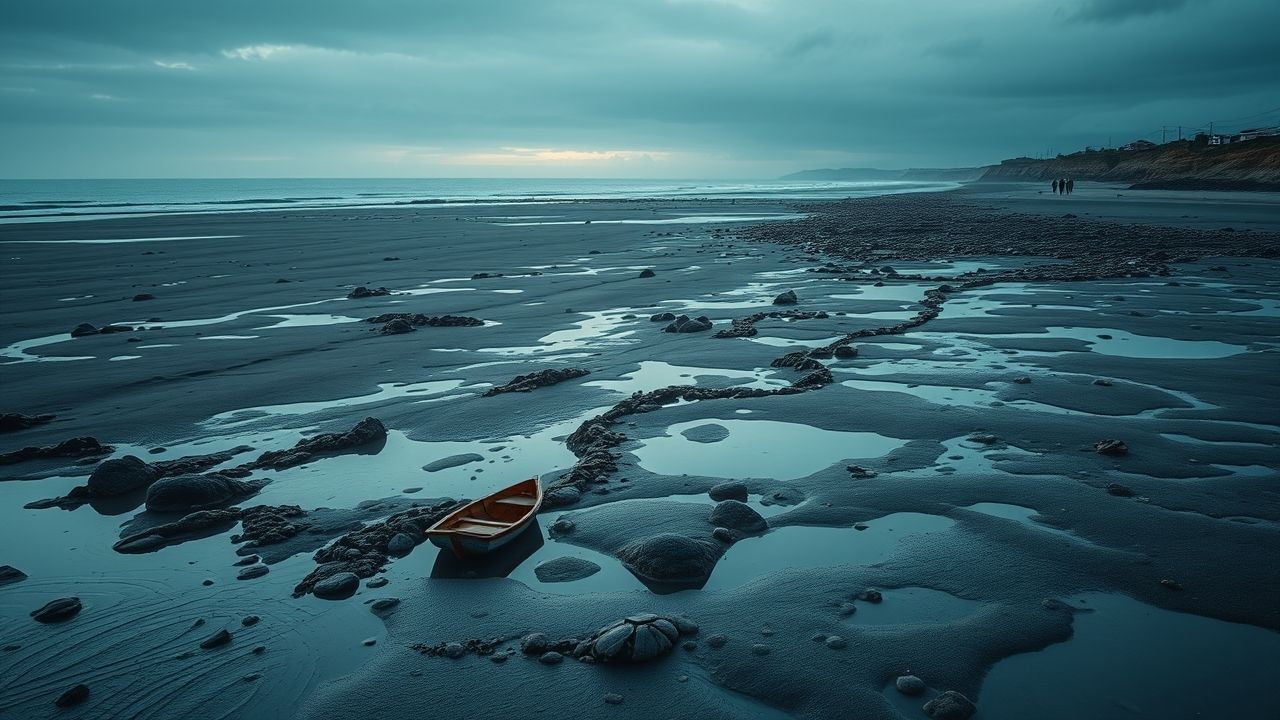The Unseen Threat: Navigating the Complexities of Tsunami Preparedness
The roar of a distant wave, an inexplicable receding tide—these can be the ominous harbingers of a tsunami, one of nature’s most destructive forces. Often misunderstood, these colossal ocean waves, triggered by seismic activity, pose an existential threat to coastal communities worldwide. As a seasoned journalist who has covered natural disasters for over a decade, I’ve seen firsthand the devastating aftermath and the incredible resilience of those affected. This article aims to demystify tsunamis, from their origins to global efforts in mitigation and preparedness, providing a comprehensive look at what makes these events so uniquely perilous.
Key Summary
- Tsunamis are primarily caused by undersea earthquakes, volcanic eruptions, or landslides, displacing massive amounts of water.
- Global warning systems, like those operated by UNESCO’s IOC, are crucial but face challenges in remote areas.
- Community preparedness, including evacuation routes and public education, is vital for saving lives.
- The impact of tsunamis extends beyond immediate destruction, affecting economies, ecosystems, and mental health for years.
- Misconceptions often arise regarding tsunami appearance and warning signs, hindering effective response.
Why This Story Matters
In my 12 years covering this beat, I’ve found that understanding natural hazards like tsunamis isn’t merely academic; it’s a matter of life and death for millions living along vulnerable coastlines. The globalized nature of trade and tourism means that a major tsunami event in one region can have ripple effects worldwide, disrupting supply chains, impacting international travel, and straining humanitarian aid resources. Beyond the immediate human toll, these events reshape coastlines, destroy critical infrastructure, and leave lasting scars on the environment and the socio-economic fabric of affected nations. Therefore, a deep dive into tsunami dynamics, historical lessons, and current preparedness strategies is not just informative but absolutely essential for policymakers, emergency responders, and the general public.
Understanding the Power of a Tsunami: Causes and Mechanics
A tsunami is not a regular ocean wave; it’s a series of powerful ocean waves caused by large-scale disturbances that displace a massive volume of water, typically from the ocean floor. The most common trigger is a submarine earthquake, especially those occurring at subduction zones where one tectonic plate is forced beneath another. When the seafloor abruptly deforms, it displaces the overlying water column, generating a wave that can travel across entire ocean basins at speeds comparable to a jet aircraft.
- Seismic Activity: Over 80% of tsunamis are generated by powerful underwater earthquakes (magnitude 7.5 or greater) that cause vertical displacement of the seafloor.
- Volcanic Eruptions: Submarine volcanic eruptions or volcanic flank collapses can also trigger tsunamis by displacing large amounts of water or creating significant pressure waves.
- Landslides: Large coastal or underwater landslides, often triggered by earthquakes or heavy rainfall, can rapidly displace water, leading to localized but highly destructive tsunamis.
As a tsunami approaches shallower coastal waters, its speed decreases, but its height dramatically increases, sometimes reaching tens of meters, creating a wall of water that crashes ashore with immense force.
Historical Perspectives: Notable Tsunami Events and Their Lessons
History is unfortunately replete with devastating tsunami events that have shaped our understanding and driven advancements in warning systems.
- 2004 Indian Ocean Tsunami: This was one of the deadliest natural disasters in recorded history. Triggered by a magnitude 9.1 earthquake off the coast of Sumatra, it generated waves that struck 14 countries, claiming over 230,000 lives. The absence of an effective early warning system for the Indian Ocean was a critical lesson learned, leading to the establishment of regional warning centers.
- 2011 Tohoku Tsunami, Japan: A magnitude 9.0 earthquake off Japan’s coast resulted in a massive tsunami that overwhelmed sophisticated defenses, caused the Fukushima Daiichi nuclear disaster, and claimed over 15,000 lives. This event highlighted that even highly prepared nations can be vulnerable and underscored the need for resilient infrastructure and robust evacuation plans.
- 1883 Krakatoa Eruption, Indonesia: The cataclysmic eruption of the Krakatoa volcano generated tsunamis up to 40 meters high that killed over 36,000 people. This historical event serves as a stark reminder of the tsunami threat posed by volcanic activity.
Global Warning Systems and Preparedness Strategies
Reporting from the heart of communities often threatened by these phenomena, I’ve seen firsthand how crucial effective early warning systems are. The Intergovernmental Oceanographic Commission (IOC) of UNESCO coordinates global tsunami warning systems for the Pacific, Indian Ocean, Caribbean, and Northeast Atlantic, Mediterranean, and connected seas. These systems rely on:
- Seismographs: To detect earthquakes and determine their location and magnitude.
- DART Buoys (Deep-ocean Assessment and Reporting of Tsunamis): These sophisticated buoys monitor sea level changes in the open ocean, providing real-time data on the passage of a tsunami wave.
- Tide Gauges: Coastal tide gauges measure sea level changes, confirming the arrival of a tsunami at the coast.
However, technology alone is insufficient. Community preparedness is paramount:
- Education and Awareness: Public education campaigns on natural warning signs (e.g., strong ground shaking, sudden sea level recession) and what to do are life-saving.
- Evacuation Routes: Clearly marked, accessible evacuation routes to higher ground are essential in coastal areas.
- Emergency Drills: Regular drills help communities practice their response plans, ensuring a swift and organized evacuation when a tsunami warning is issued.
Expert Analysis: The Science of Coastal Resilience
In my extensive interviews with oceanographers and disaster management experts, a recurring theme emerges: the urgent need for coastal resilience. This goes beyond just warning systems and involves a multifaceted approach to mitigate the impact of future tsunamis.
“Building resilience isn’t just about concrete walls; it’s about empowering communities with knowledge, restoring natural buffers like mangroves and coral reefs, and integrating disaster risk reduction into urban planning. A holistic approach is the only way forward against the increasing frequency and intensity of extreme events.” – Dr. Anya Sharma, Coastal Geologist.
Efforts include:
- Nature-Based Solutions: Reforestation of mangrove forests and preservation of coral reefs can act as natural barriers, dissipating wave energy.
- Land-Use Planning: Restricting development in highly vulnerable coastal zones and zoning for green spaces that can absorb inundation.
- Building Codes: Implementing strict building codes for structures in tsunami-prone areas to withstand significant water forces.
Common Misconceptions About Tsunamis
Despite widespread awareness, several misconceptions persist regarding tsunamis that can jeopardize safety.
- “A tsunami is a single, giant wave.” In reality, a tsunami is a series of waves, often with the first wave not being the largest. The danger can last for hours as subsequent waves arrive.
- “You’ll see a towering wall of water from far away.” While some tsunamis present this way, often the first sign is a rapid and unusual recession of the sea, exposing the seafloor. This is not an invitation to explore; it’s a clear warning to seek higher ground immediately.
- “Only coastal areas directly facing the ocean are at risk.” Estuaries, rivers, and bays can funnel tsunami waves far inland, making areas seemingly protected from the open ocean vulnerable.
- “If you’re offshore in a boat, you’re safe.” In deep water, a tsunami is barely noticeable, but boats can be carried inland or capsized by the immense currents as the wave approaches shore. The safest place during a tsunami is in deep open water, far from land.
Frequently Asked Questions
- What is the difference between a tsunami and a regular ocean wave?
A regular ocean wave is primarily generated by wind and affects only the surface of the water, while a tsunami is caused by large-scale displacement of the entire water column, often from underwater seismic events, affecting the ocean from surface to seabed. - How fast can a tsunami travel?
In the deep ocean, tsunamis can travel at speeds of up to 800 kilometers per hour (500 mph), similar to a jet plane. Their speed decreases as they approach shallower water, but their height increases dramatically. - What are the natural warning signs of a tsunami?
Natural warning signs include a strong earthquake felt in a coastal area, a sudden and unusual receding of the ocean far beyond the normal low tide mark, or a loud roar coming from the ocean. - Can animals sense a tsunami coming?
There is anecdotal evidence and some scientific speculation that animals may be able to sense an approaching tsunami due to their heightened senses detecting subtle changes like seismic vibrations or infrasound, leading them to seek higher ground. - What should I do if a tsunami warning is issued?
If a tsunami warning is issued, immediately move to higher ground as far inland as possible. Follow designated evacuation routes and official instructions, and do not return until authorities declare it safe.








